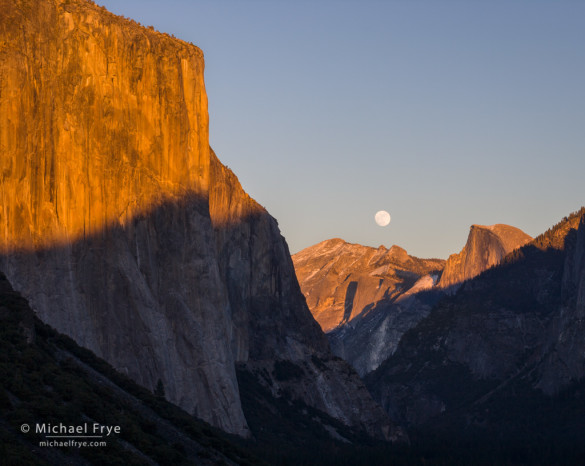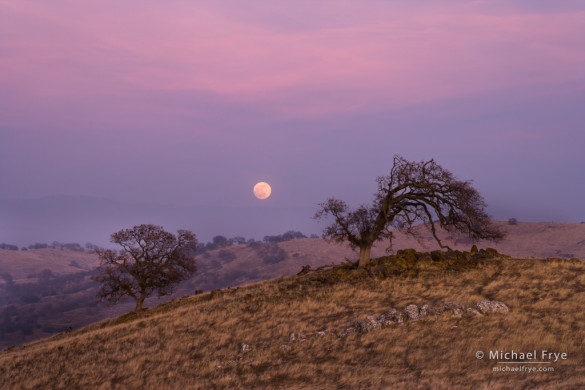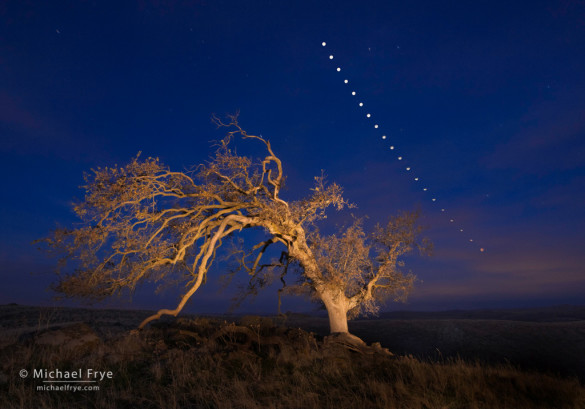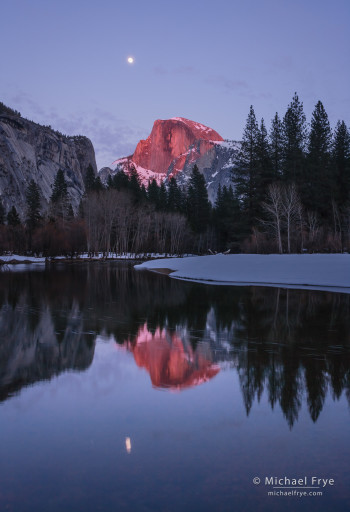by Michael Frye | Jan 19, 2014 | Yosemite Photo Conditions

Moonrise from Tunnel View, Yosemite NP, CA, USA
During my Landscapes in the Digital Darkroom workshop last week for The Ansel Adams Gallery we photographed two moonrises, including this one on Tuesday from Tunnel View. The moon appeared right over Cloud’s Rest, between Half Dome and El Capitan, just before sunset – a spectacular sight. I’ve included two versions here: a black-and-white image just as the moon climbed into view (below), and a color version when the moon rose a little higher (above).
(more…)
by Michael Frye | Jan 14, 2014 | Announcements
We had a great response to the PhotoPills giveaway, with nearly 300 people putting their names into the hat. We assigned each person who entered a number, and used a random number generator to select the five winners. And the winners are…
John (email starts with jwtrone)
Mike Lynch
Dk Tanaka
Howard Snyder
Susan Markovic
Congratulations to the winners! You’ll each receive an email shortly from Claudia with a code for downloading a free copy of PhotoPills. And if you didn’t get lucky this time, the app is only $9.99, and well worth the price.
Thanks to all of you who participated, and good luck with your moon photos!
— Michael Frye
by Michael Frye | Jan 12, 2014 | Announcements

Moonrise, Sierra foothills, Mariposa Country, CA, USA
In my December post Moonstruck I talked about the two best apps for figuring out sun and moon positions: PhotoPills and The Photographer’s Ephemeris.
I’ve relied on The Photographer’s Ephemeris for many years; it’s a great tool. PhotoPills is newer, but as I’ve become more familiar with it I’ve used it more and more. PhotoPills has a couple of very useful extra features, like it’s Augmented Reality mode, which allows you to superimpose the future path of the sun, moon, or other celestial object over a live picture (on your iPhone) of the scene in front of you. Even better, if you want to photograph the sun or moon lined up with a certain object – a building, or a mountain, for example – you can search for the times when that will happen, and see a list of results which includes moon phases, and the days when your desired alignment corresponds with the “magic” hour.
How to Win a Free Copy of PhotoPills:
This app is normally only $9.99, but Rafael Pons at PhotoPills has generously offered to give away five copies of this app to my readers. To have a chance to win, just post a comment below saying you’re interested. There’s one catch: you must own an iPhone or iPod Touch! PhotoPills is only available for the iPhone so far. (A universal app formatted for the iPad is in the works, but not available yet.) You have until midnight tomorrow (Monday, January 13th) Pacific time to post a comment and have a chance to win.
(more…)
by Michael Frye | Dec 30, 2013 | Announcements

Oak tree and lunar eclipse sequence, Mariposa County, Sierra foothills, CA, USA
One of my most popular posts this year was a recent one, called Moonstruck. This article focused on how to capture moonrise and moonset photographs, with a discussion about how to predict the moon’s movements, and apps that can help with figuring out the precise position of the sun and moon.
While the Moonstruck article focused on photographing moonrises and moonsets, I’ve also written about photographing by moonlight. Tips for Photographing Lunar Rainbows delves into the specifics of moonlight photography: camera settings, shutter speeds, and how to focus in the dark. And in another post from 2012 I described the experience of photographing lunar rainbows in Yosemite, first with the crowds of photographers in Cook’s Meadow, then along the Upper Yosemite Falls Trail. And then late last year I wrote about my most memorable New Year’s Eve, and how that inspired me to make a photograph of the Three Brothers by moonlight.
(more…)
by Michael Frye | Dec 13, 2013 | Photography Tips, Yosemite Photo Conditions

Half Dome and moon at sunset, February 18th, 2008
There’s something magical about the moon. Putting the moon in a photograph adds a sense of mystery and timelessness, and can elevate an otherwise ordinary scene into something special. Ansel Adams confessed to being “moonstruck,” and I suppose I am too.
The moon will be full next Tuesday (at 1:28 a.m. here on the west coast), and I’m sure many photographers will be trying to capture a rising or setting moon during the coming days, so I thought I would share some ideas about photographing the full moon, and clear up some misconceptions.
Misconception #1
One misconception is that moonrise or moonset photos are taken at night. They’re not: they’re almost invariably made near sunrise or sunset. After dark the contrast between the moon and the landscape is too great, and a good exposure for the moon will make the landscape completely black, while a good exposure for the landscape will wash out the moon. Around sunrise and sunset it’s possible to balance the light between the moon and the landscape and get detail in both, yet have a dark enough sky for the moon to stand out clearly.
Misconception #2
Another misconception is that moonrise or moonset photos are made on the date when your calendar says “full moon.” This can work if the terrain is flat, or you’re at a high vantage point. But if there are mountains or ridges blocking your view of the horizon, you’re better off photographing a moonrise one to three days before the full moon, and a moonset one to three days after the full moon. While the moon won’t technically be full, it will look full enough, and be in a better position than on the actual full moon night. Here’s why:
(more…)












